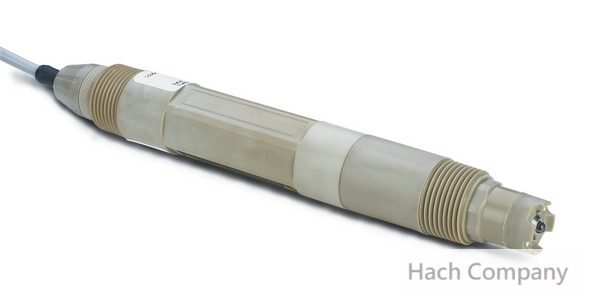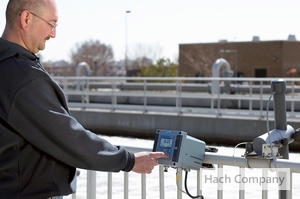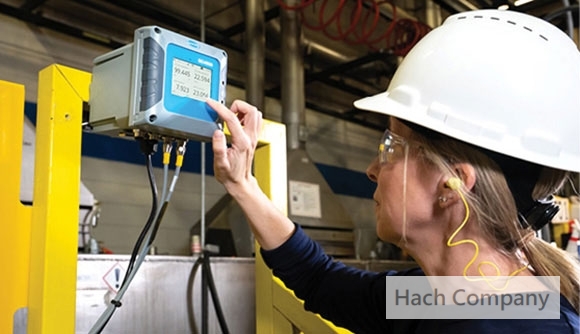水中pH感測器 pHD sc: Digital pH sensor with glass differential electrode, sc compatibility, PEEK®, Convertible Mount
產品編號:DPD1P1
The smart choice for accurate and reliable online process pH measurement
Hach專利測量技術準確可靠線上監測水中酸鹼值,減少停機時間和人力維護
Hach’s patented differential electrode measurement technique ensures more accurate pH readings, providing increased reliability to reduce downtime and maintenance for measuring pH over traditional pH sensors.
Our DPD1P1 digital pH probe is Convertible Mount complete with a 10m cable and compatible with Hach SC controllers.
使用Hach sc系列數位控制主機進行監控,連接後即可使用
Range 量測範圍 : -2.0 to 14.0 pH
Repeatability 重複性 : ± 0.05 pH
Sensitivity : ± 0.01 pH
Accuracy 準確度 : ± 0.02 pH
Calibration Method 校正方法 : Two point automatic, one point automatic, two point manual, one point manual
Communication 通訊傳輸 : Modbus
Compliance 合規 : Hazardous location, Maritime, CE
Operating Temperature Range : -5 - 70 °C (23 - 158 °F) pHD and ORP
0 - 50 °C (32 - 122 °F) SS pHD
Temperature Sensor 溫度感測補償 : NTC 300 Ω thermistor for automatic temperature compensation and analyzer temperature readout
Before initial pH calibration, calibrate the temperature measurement when the sensor is in water or buffer which is at approximately the same temperature as the pH buffers (matches current recommendation)
Pressure Range 壓力範圍 : Maximum 10.7 bar. 6.9 bar for Digital Sensor at 70°C, and 6.9 bar for Analog Sensor at 105°C.
Applications 應用 :
Membrane Protection
Nutrient Monitoring
Secondary Treatment
Ultrapure Water
This instrument connects to Claros, Hach’s innovative Water Intelligence System, enabling you to seamlessly connect and manage instruments, data, and process – anywhere, anytime. The result is greater confidence in your data and improved efficiency in your operations. To unlock the full potential of Claros, insist on Claros Enabled instruments. Digital pH sensor可無縫連接 Hach 的創新水務智能系統 Claros,隨時隨地管理儀器、數據和監測程序。有效提高營運效率。
關鍵字 : 水中 pH計 線上感測, 水中 酸鹼值 線上監測儀, 水 pH 線上分析儀, 水 pH 測定, pH analyzer, 水中 酸鹼值計, 線上監測酸鹼度, 酸鹼值感測器
Hach專利測量技術準確可靠線上監測水中酸鹼值,減少停機時間和人力維護
Hach’s patented differential electrode measurement technique ensures more accurate pH readings, providing increased reliability to reduce downtime and maintenance for measuring pH over traditional pH sensors.
Our DPD1P1 digital pH probe is Convertible Mount complete with a 10m cable and compatible with Hach SC controllers.
使用Hach sc系列數位控制主機進行監控,連接後即可使用
Range 量測範圍 : -2.0 to 14.0 pH
Repeatability 重複性 : ± 0.05 pH
Sensitivity : ± 0.01 pH
Accuracy 準確度 : ± 0.02 pH
Calibration Method 校正方法 : Two point automatic, one point automatic, two point manual, one point manual
Communication 通訊傳輸 : Modbus
Compliance 合規 : Hazardous location, Maritime, CE
Operating Temperature Range : -5 - 70 °C (23 - 158 °F) pHD and ORP
0 - 50 °C (32 - 122 °F) SS pHD
Temperature Sensor 溫度感測補償 : NTC 300 Ω thermistor for automatic temperature compensation and analyzer temperature readout
Before initial pH calibration, calibrate the temperature measurement when the sensor is in water or buffer which is at approximately the same temperature as the pH buffers (matches current recommendation)
Pressure Range 壓力範圍 : Maximum 10.7 bar. 6.9 bar for Digital Sensor at 70°C, and 6.9 bar for Analog Sensor at 105°C.
Applications 應用 :
Membrane Protection
Nutrient Monitoring
Secondary Treatment
Ultrapure Water
This instrument connects to Claros, Hach’s innovative Water Intelligence System, enabling you to seamlessly connect and manage instruments, data, and process – anywhere, anytime. The result is greater confidence in your data and improved efficiency in your operations. To unlock the full potential of Claros, insist on Claros Enabled instruments. Digital pH sensor可無縫連接 Hach 的創新水務智能系統 Claros,隨時隨地管理儀器、數據和監測程序。有效提高營運效率。
關鍵字 : 水中 pH計 線上感測, 水中 酸鹼值 線上監測儀, 水 pH 線上分析儀, 水 pH 測定, pH analyzer, 水中 酸鹼值計, 線上監測酸鹼度, 酸鹼值感測器
Differential pH Sensor With Encapsulated Preamp: Using three electrodes versus the traditional two increases accuracy in this digital pH probe. Reference junction potential is reduced along with elimination of sensor ground loops.
This field-proven technique uses three electrodes instead of the two normally used in conventional pH sensors. Process and reference electrodes measure the pH differentially with respect to a third ground electrode. The end result is unsurpassed measurement accuracy, reduced reference junction potential, and elimination of sensor ground loops. These process pH sensors provide greater reliability, resulting in less downtime and maintenance.
This field-proven technique uses three electrodes instead of the two normally used in conventional pH sensors. Process and reference electrodes measure the pH differentially with respect to a third ground electrode. The end result is unsurpassed measurement accuracy, reduced reference junction potential, and elimination of sensor ground loops. These process pH sensors provide greater reliability, resulting in less downtime and maintenance.
Extended pH Sensor Life: Replaceable salt bridge holds higher volumes of buffer which extends pH sensor life and protects the junction reference electrode.
The double junction salt bridge creates a barrier to contamination which minimizes the dilution of the internal standard cell solution. The result is lower maintenance needs and a longer time period between calibrations.
The double junction salt bridge creates a barrier to contamination which minimizes the dilution of the internal standard cell solution. The result is lower maintenance needs and a longer time period between calibrations.
Durable Material Build For Aggressive Solutions: PEEK ® is used in construction of the body for chemical compatibility with most process applications for in line pH monitoring.
The unique, replaceable salt bridge holds an extraordinary volume of buffer to extend the working life of the sensor by protecting the reference electrode from harsh process conditions. The salt bridge simply threads onto the end of the sensor if replacement is needed.
The unique, replaceable salt bridge holds an extraordinary volume of buffer to extend the working life of the sensor by protecting the reference electrode from harsh process conditions. The salt bridge simply threads onto the end of the sensor if replacement is needed.
Versatile Mounting Options: pH sensors are available in four mounting styles – convertible, insertion, immersion, and sanitary for real time pH monitoring. The DPD1P1 is convertible build. Order our digital pHD today!
Encapsulated construction protects the sensor’s built-in preamp from moisture and humidity, ensuring reliable sensor operation. The preamp in the pHD analog sensor produces a strong signal, enabling the sensor to be located up to 1000 m (3280 ft.) from the analyzer.
Patented Technology
The former GLI, now a Hach Company brand, invented the Differential Electrode Technique for pH measurement in 1970. The pHD sensor series (U.S. Patent Number 6395158B1, dated May 28, 2002) takes this field-proven technology to a new level.



